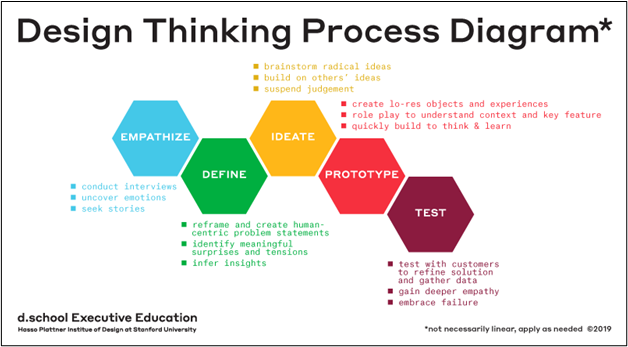Week 1 Overview: What is Design Thinking?
Introduction

Welcome to Introduction to Design Thinking! Throughout this course you’ll learn how to envision, explain, and evaluate solutions to a wide range of human problems involving information and interaction skills. These skills include user research methods, visual and interaction design skills, methods for evaluating designs, and skills for communicating your designs.
Our first week of class will orient us to what design thinking is as a process, and the many different creative modes of problem-solving and innovation it can encompass. We’ll master the basic concepts that form the foundation of design thinking, examine different cultural approaches to and myths about design thinking, and we’ll also critically analyze the limits and liabilities of the design thinking process. We’ll also kick off our own design thinking projects that we’ll be tackling step-by-step on a weekly basis. By the end of this course, you will have moved through the entire design thinking process!
Course Competencies:
- Develop a strong understanding of the design thinking process and how it can be applied in a variety of industry settings.
- Understand the terminology and conceptual models used in design disciplines.
- Recognize the ethical and social dilemmas and obligations of the practice of design.
- Diagnose common adoption barriers in individuals, groups and organizations.
- Participate in and lead innovation in creative and collaborative settings.
- Undertake complex and unstructured problem-solving challenges in unfamiliar domains.
- Identify the necessary skill sets and mindset to practice design thinking.
- Utilize a human-centered approach to research to understand and tackle complex social problems and build empathy for target audiences.
- Create prototypes and/or proof of concepts for user testing.
- Develop and test innovative ideas through a rapid iteration cycle.
Learning Objectives:
- Become familiar with the basic concepts behind design thinking.
- Become familiar with divergence and overlap in various scholarly interpretations of design thinking.
- Become familiar with the cultural mythos around design thinking.
- Understand the limitations, liabilities, and affordances possible with applied design thinking.
To-Do List: (in sequential order)
- Section 1: What is Design Thinking?
- Reading/Viewing:
- Design Thinking (Library Futures) – CH 1: Understanding Design Thinking
- IDEO Design Thinking
- Design Thinking for Strategic Innovation – CH 2: What is Design Thinking, Really?
- On Design Thinking: A Simultaneously Over-Discussed and Under-Explored Subject
- Natasha Jen: Design Thinking is Bullsh*t
- Reading/Viewing:
- Section 2: The Project
- Section 3: Breaking Down the Mythos: Limitations and Liabilities in and Around Design Thinking
- Reading/Viewing:
- Decolonizing Design
- About “moving fast and breaking things” — a designer’s perspective
- Reading/Viewing:
- Section 4: What the Mythos and Reality Mean for Us as Students
- Discussion Board:
- Compare/Contrast
- Why Design Thinking?
- Assignment:
- Set Up Project Folder in Google Drive and Get Started With Miro
- Reading/Viewing:
- Getting Started with Miro